Over the several years that Chris Carlson and I have been running scenarios of Harpoon, Command at Sea (CaS), or Fear God & Dread Nought (FG & DN) at HMGS East Conventions Cold Wars and Historicon, we have frequently been asked questions about historical tactics or gamespecific tactics, and especially “what should I have done?” when something went wrong.
At Cold Wars 2002, we were asked a very different type of question. Essentially, the question was ‘can you guys walk it like you talk it?' Can the Sea Lords actually play and win or do they just design? Chris and I grinned at each other and readily accepted the challenge.
Plans were made to use the same basic setup and layout as one of the events that we were already running at Historicon 2002: Gunboat Diplomacy III for FG & DN using the Ship Combat Value Equivalency (SCVE) system {ed: see article on the SCVE system in the previous SITREP}. Our challengers for this historic match were a group of avid gamers who called themselves the ‘Slippery Weasels'. They have been very enthusiastic and vocal supporters of Admiralty Trilogy games, especially at Historicons.
The Weasels opted to use German ships for the battle, leaving Chris and I as the Sea Lords* to use British ships. *(Author’s Note: Larry Bond is First Sea Lord, Chris Carlson is Second Sea Lord, Ed Kettler is Third Sea Lord, and Mike Harris is Fourth Sea Lord of the Admiralty Trilogy). Both sides had around 3600 SCVE points to build their fleets from miniatures that would be available for the FG & DN event.
Selecting the ships we wanted to comprise our fleet went hand in hand with choosing the tactics we wanted to employ. We knew British-designed ships favored guns over torpedoes, and using Royal Navy ships, we would have to do the same. The basic layout of the battle area would be waters surrounding the tiny island of Oz and inside the mystic fog bank that surrounded the isle. A Weasel attack in the fog with German torpedoes could be deadly, so early detection the Weasels was critical.
We decided on an initial cautious approach, backed by a massive reaction once the enemy was found.
We also assigned specific missions to the two groups of our fleet. Group Beatty, with two battle cruisers and a destroyer division, was assigned to destroy the Weasel light forces. Group Jellicoe, with four battleships and a light cruiser-led destroyer division, was responsible for destroying the Weasel capital ships. This mission assignment proved to be one of the better tactical choices as events transpired. Group Beatty’s destroyers would enter the clear area from the fog first to assess the situation, followed by the battle cruisers.
Group Jellicoe would either follow or stay in the fog. To help with the ambiance of the event, Chris and I also spelled out all of our tactical choices in a signals ‘cookbook’ so we could quickly report and task one another as needed (much like actual Navy signals and code books). We put these to use during the event and were able to keep communications lag to a minimum while using the FG & DN rules. (We also hoped using pre-arranged signals would help psych out the Weasels. It definitely provoked multiple groans, stares, and twitches. Not all victories are won on the battlefield!)
The Weasels steamed out in a classical formation. All the light forces were arrayed in front of the main body; three divisions of destroyers with light cruiser leaders, with a column of three battle cruisers followed by a column of two battleships. The Weasel Fleet steamed straight into the clear waters and headed south. Then the shooting (and fun) began.
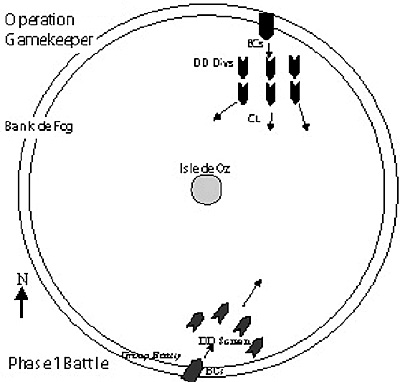 The battle had five phases. In Phase 1, the Weasel formation came straight in. The Sea Lords sent Group Beatty in first to scout and screen for Group Jellicoe, which stayed in the fog until signaled to come out or take other action as required.
The battle had five phases. In Phase 1, the Weasel formation came straight in. The Sea Lords sent Group Beatty in first to scout and screen for Group Jellicoe, which stayed in the fog until signaled to come out or take other action as required.
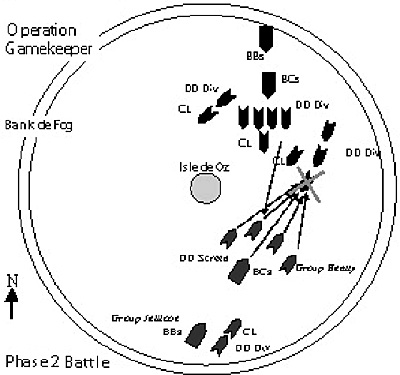 In Phase 2, the Weasel formation began to break up as the two easterly destroyer divisions took independent action to increase speed and move forward for a torpedo attack. Fortunately (or unfortunately depending on one’s perspective), they attacked separately by division and not as a massed attack. The leading division was easily wiped out by the firepower of Group Beatty.
In Phase 2, the Weasel formation began to break up as the two easterly destroyer divisions took independent action to increase speed and move forward for a torpedo attack. Fortunately (or unfortunately depending on one’s perspective), they attacked separately by division and not as a massed attack. The leading division was easily wiped out by the firepower of Group Beatty.
The Weasel battle cruisers also increased speed as they headed south to engage the battle cruisers of Group Beatty. The westerly Weasel destroyer division and light cruiser broke to west to try for a flanking maneuver on the other side of the island. In the meantime Group Jellicoe emerged from the fog.
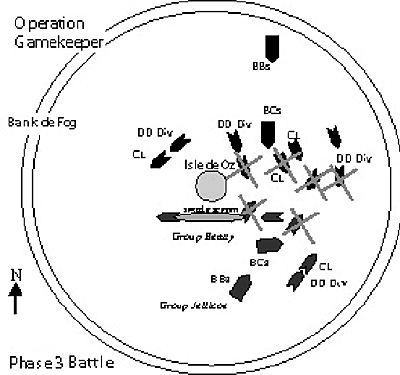 In Phase 3, the action intensified. More Weasel destroyers were eliminated during piecemeal attacks, but some Group Beatty destroyers were also lost. A smoke screen was deployed by a Group Beatty destroyer to block any sighting by the Weasel west column.
In Phase 3, the action intensified. More Weasel destroyers were eliminated during piecemeal attacks, but some Group Beatty destroyers were also lost. A smoke screen was deployed by a Group Beatty destroyer to block any sighting by the Weasel west column.
The Weasel battle cruisers began to fire on the Group Beatty battle cruisers, whose main focus stayed. xed on wiping out remaining Weasel destroyers and light
cruisers. Meanwhile, battleships from Group Jellicoe began to. re on the Weasel battle cruisers. A few extreme range shots were tried by the Weasel battleships at Group
Jellicoe battleships, but these were ignored.
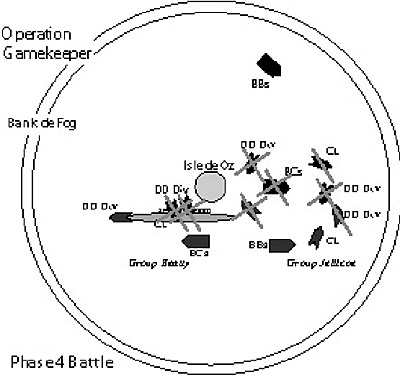 During Phase 4, Weasel forces were badly mauled. Just as the Weasel battle cruisers changed course to parallel the battle cruisers of Group Beatty, Group Beatty
executed a battle turn to the west in order to engage the remaining Weasel destroyer division that was closing from the west. This left the Weasel battle cruisers steaming
parallel to Group Jellicoe battleships at medium range.
During Phase 4, Weasel forces were badly mauled. Just as the Weasel battle cruisers changed course to parallel the battle cruisers of Group Beatty, Group Beatty
executed a battle turn to the west in order to engage the remaining Weasel destroyer division that was closing from the west. This left the Weasel battle cruisers steaming
parallel to Group Jellicoe battleships at medium range.
As the Weasels' western thrust emerged from the fog, it was met by the withering fire of Group Beatty at close range. When this fusillade combined with a high speed
collision in the smoke, the Weasel western column quickly ceased to exist. The Weasel battle cruisers did not survive too long either, as the heavier firepower and armor of
Group Jellicoe battleships and a couple of well-aimed torpedoes sank the battle cruisers one after the other in quick succession. The Weasel battleships continued to fire at long ranges at Group Jellicoe, but still had little effect and continued to be ignored.
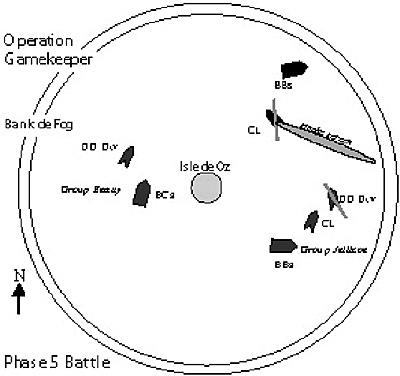 In Phase 5, the outcome had become very clear and the remaining Weasel light cruiser laid a smoke screen to help the Weasel battleships escape into the fog. As the no-longer-ignored Weasel battleships faded from view, the pursuit by Group Beatty and Group Jellicoe light forces was called off. The battle was over and the Sea Lords had won the day.
In Phase 5, the outcome had become very clear and the remaining Weasel light cruiser laid a smoke screen to help the Weasel battleships escape into the fog. As the no-longer-ignored Weasel battleships faded from view, the pursuit by Group Beatty and Group Jellicoe light forces was called off. The battle was over and the Sea Lords had won the day.
The engagement was an overwhelming victory for the Sea Lords and cemented their reputation as Masters of Naval Tactics (or so we claim). The Weasel Fleet had been decimated with minimal damage to Sea Lord capital ships and slightly more than moderate losses among light forces.
So what was the source or cause of such a lopsided victory? Was it all luck or just pure brilliance? Actually it was a bit of both, with a healthy portion of experience and knowledge of history. Both Chris and I are experienced enough gamers to realize that the dice can run with you or against you. We chose tactics that allowed us to mitigate bad dice or take advantage of good dice. Just like in a real sea battle, where sometimes the waves break for you and sometimes against -– it is what you do with the breaks that makes the difference.
Fortunately for the good guys, the Sea Lords appeared to be as much in command of their dice as they were of their ships. We had good luck with the dice and took full advantage of it. We also took advantage of gaps in the Weasel formations and maneuvers. This is where our study of historical tactics and strategy paid off. Eliminating the Weasel destroyer divisions in sequence removed the very dangerous threat of a massed torpedo attack. We used our destroyer screen to help break things up and then focused firepower on one division at a time as they sailed into our crosshairs.
The biggest tactical coup and maneuver that earned the wail of, “that ain't right, that ain't right. .. its. .. its. .. just wrong!” was the battle turn by the Group Beatty battle cruisers. In Phase 3, the three Weasel battle cruisers swung into a parallel course with the Group Beatty battle cruisers and prepared for a 3: 2. refight between battle cruisers. Great joy shone in the eyes of the Weasels as they anticipated payback for the massacre of their destroyers. But that joy quickly faded as the Group Beatty battle cruisers turned 180 ° to head in the other direction to go after the remaining Weasel light forces. Even worse, this left the Weasel battle cruisers facing the four battleships of Group Jellicoe, eager juggernauts that had been safely screened by the now-disappearing Group Beatty battle cruisers.
Needless to say, the results weren't pretty. Did we plan it that way? Not at first, no. But when we saw what was going on, Chris moved his battleships behind my battle cruisers, which I left as bait for the three Weasel battle cruisers. When they took it, I executed a preplanned order to go after remaining Weasel light forces and left Chris free to pound and pummel. It was glorious. Everyone involved had a great time and really enjoyed the event. Considering the late hour, we were amazed at the number of spectators that stopped by to watch. The event was such a success that we agreed to try it again with different forces and teams.
This time, the Weasels issued a challenge for any other player group to meet them on the high seas. In the meantime, the Sea Lords will await a truly worthy adversary.
We had planned for this second ‘challenge match' to be an event at Historicon ‘03, including full use of the Communications Rules, shore batteries, and mine fields in a Russian vs. German WW I Baltic Brawl. However, events conspired against the battle and we had to cancel. We're hoping that maybe we can pull it off next year at Historicon 2004.
In response to several requests, here is the scenario we played for those who may care to try:
BT
Back to The Naval Sitrep # 26 Table of Contents
Back to Naval Sitrep List of Issues
Back to MagWeb Master Magazine List
& copy Copyright 2004 by Larry Bond and Clash of Arms.
This article appears in MagWeb.com (Magazine Web) on the Internet World Wide Web.
Other military history and related articles are available at http://www.magweb.com